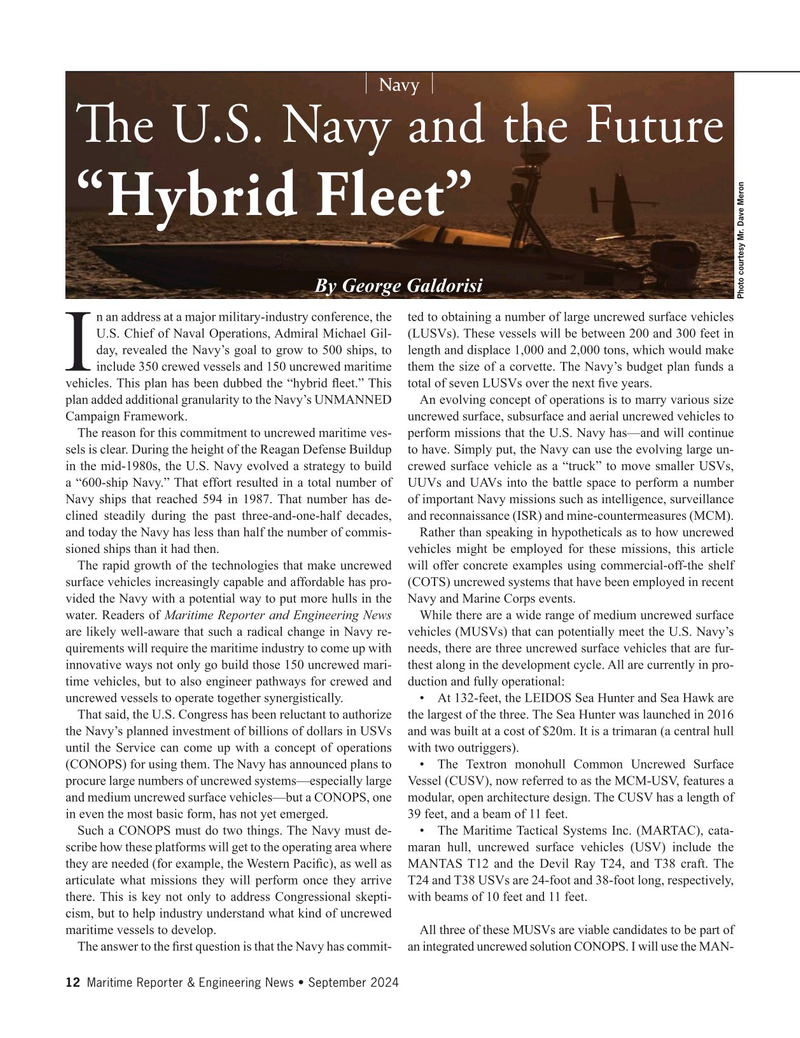
Page 12: of Maritime Reporter Magazine (September 2024)
Read this page in Pdf, Flash or Html5 edition of September 2024 Maritime Reporter Magazine
Navy
T e U.S. Navy and the Future “Hybrid Fleet”
By George Galdorisi
Photo courtesy Mr. Dave Meron n an address at a major military-industry conference, the ted to obtaining a number of large uncrewed surface vehicles
U.S. Chief of Naval Operations, Admiral Michael Gil- (LUSVs). These vessels will be between 200 and 300 feet in day, revealed the Navy’s goal to grow to 500 ships, to length and displace 1,000 and 2,000 tons, which would make include 350 crewed vessels and 150 uncrewed maritime them the size of a corvette. The Navy’s budget plan funds a
I vehicles. This plan has been dubbed the “hybrid ? eet.” This total of seven LUSVs over the next ? ve years. plan added additional granularity to the Navy’s UNMANNED An evolving concept of operations is to marry various size
Campaign Framework. uncrewed surface, subsurface and aerial uncrewed vehicles to
The reason for this commitment to uncrewed maritime ves- perform missions that the U.S. Navy has—and will continue sels is clear. During the height of the Reagan Defense Buildup to have. Simply put, the Navy can use the evolving large un- in the mid-1980s, the U.S. Navy evolved a strategy to build crewed surface vehicle as a “truck” to move smaller USVs, a “600-ship Navy.” That effort resulted in a total number of UUVs and UAVs into the battle space to perform a number
Navy ships that reached 594 in 1987. That number has de- of important Navy missions such as intelligence, surveillance clined steadily during the past three-and-one-half decades, and reconnaissance (ISR) and mine-countermeasures (MCM).
and today the Navy has less than half the number of commis- Rather than speaking in hypotheticals as to how uncrewed sioned ships than it had then. vehicles might be employed for these missions, this article
The rapid growth of the technologies that make uncrewed will offer concrete examples using commercial-off-the shelf surface vehicles increasingly capable and affordable has pro- (COTS) uncrewed systems that have been employed in recent vided the Navy with a potential way to put more hulls in the Navy and Marine Corps events.
water. Readers of Maritime Reporter and Engineering News While there are a wide range of medium uncrewed surface are likely well-aware that such a radical change in Navy re- vehicles (MUSVs) that can potentially meet the U.S. Navy’s quirements will require the maritime industry to come up with needs, there are three uncrewed surface vehicles that are fur- innovative ways not only go build those 150 uncrewed mari- thest along in the development cycle. All are currently in pro- time vehicles, but to also engineer pathways for crewed and duction and fully operational: uncrewed vessels to operate together synergistically. • At 132-feet, the LEIDOS Sea Hunter and Sea Hawk are
That said, the U.S. Congress has been reluctant to authorize the largest of the three. The Sea Hunter was launched in 2016 the Navy’s planned investment of billions of dollars in USVs and was built at a cost of $20m. It is a trimaran (a central hull until the Service can come up with a concept of operations with two outriggers).
(CONOPS) for using them. The Navy has announced plans to • The Textron monohull Common Uncrewed Surface procure large numbers of uncrewed systems—especially large Vessel (CUSV), now referred to as the MCM-USV, features a and medium uncrewed surface vehicles—but a CONOPS, one modular, open architecture design. The CUSV has a length of in even the most basic form, has not yet emerged. 39 feet, and a beam of 11 feet.
Such a CONOPS must do two things. The Navy must de- • The Maritime Tactical Systems Inc. (MARTAC), cata- scribe how these platforms will get to the operating area where maran hull, uncrewed surface vehicles (USV) include the they are needed (for example, the Western Paci? c), as well as MANTAS T12 and the Devil Ray T24, and T38 craft. The articulate what missions they will perform once they arrive T24 and T38 USVs are 24-foot and 38-foot long, respectively, there. This is key not only to address Congressional skepti- with beams of 10 feet and 11 feet. cism, but to help industry understand what kind of uncrewed maritime vessels to develop. All three of these MUSVs are viable candidates to be part of
The answer to the ? rst question is that the Navy has commit- an integrated uncrewed solution CONOPS. I will use the MAN- 12 Maritime Reporter & Engineering News • September 2024
MR #9 (1-17).indd 12 9/3/2024 8:50:37 AM

 11
11

 13
13
